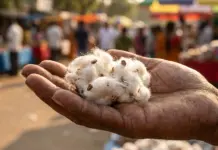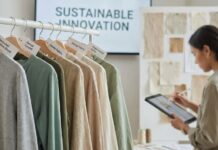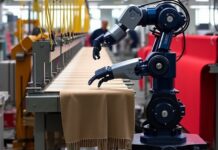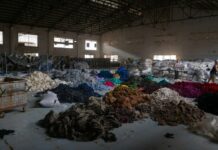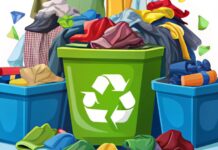An evolving database will allow brands to evaluate the environmental footprints of commonly used fibers through a sustainable fiber footprint assessment.
The fashion industry has a profound impact on waste and the environment, with nearly 75% of clothing produced each year ending up in landfills or incinerated—equating to almost 20 billion pounds annually in the United States alone.
The fundamental elements of these garments—fibers and yarns—hold the key to addressing this substantial issue.
Recent funding from the Walmart Foundation will enable researchers at the Wilson College of Textiles, in collaboration with the North Carolina Textile Innovation and Sustainability Engine (The Textile Engine), to tackle this challenge.
The Wilson College is spearheading the research and development for The Textile Engine, a National Science Foundation (NSF) Regional Innovation Engine, which involves a partnership with The Industrial Commons, NC State, and other significant regional contributors.
With a new grant of $350,000, researchers will perform life cycle assessments (LCAs) for materials composed of some of the most prevalent new and recycled fibers utilized in the fashion sector. LCAs are comprehensive, data-driven reports that outline the estimated environmental impacts associated with producing a product (in this instance, yarns), including air pollution, wastewater management, and energy consumption. These assessments are crucial for conducting a sustainable fiber footprint assessment.
Melissa Sharp, deputy CEO of research and development for The Textile Engine, stated, “With this generous gift from the Walmart Foundation, we are able to accelerate Life Cycle Assessment work and expand to include more materials.”
This information will become a crucial resource for product developers, allowing them to make informed comparisons and select yarns that align with their brand’s sustainability objectives while adhering to necessary performance criteria.
“It’s not a matter of what is the most sustainable material, but it’s a matter of what you’re trying to address, because there are costs and benefits to every material,” explained Professor Karen Leonas, who will oversee the LCAs.
One fiber might require less energy for processing but could contribute to heightened air pollution.
Since all LCAs will be conducted by the same research team under consistent parameters, this initiative will allow developers to make accurate, direct comparisons.
“There is nothing like this available today for fiber materials,” Sharp noted.
Additionally, LCAs are an essential tool for any brand seeking to promote its products with sustainability claims. Research indicates that consumers are willing to pay a premium for sustainably produced items. However, studies also show that these consumers are becoming increasingly skeptical about environmental claims made by companies, pushing brands to be more transparent and accurate regarding their product’s sustainability. LCAs can provide the evidence needed for companies to earn the trust of discerning consumers.
“Brands and retailers have to be able to substantiate their marketing claims on these materials,” emphasized The Textile Engine CEO Anne Wiper.
Overcoming Challenges in Conducting LCAs
To create LCAs, comprehensive data must be collected at each stage of the production process and entered into a computational model. Taking cotton as an example, an LCA for the environmental impact of cotton fiber, even before it reaches the cotton gin, would include:
-
The geographic location of cotton cultivation,
-
Whether seeds are planted mechanically or by hand,
-
Pesticide usage,
-
Water consumption,
-
Among other factors.
“These assessments are extremely detailed and time-consuming to develop,” noted Leonas.
In essence, carrying out an LCA can be too labor-intensive for most product development teams to incorporate into their workflows. Though open LCA models exist, they often overlook many textile-specific processes and considerations. Moreover, hiring an external company to carry out an LCA can incur significant financial burdens on businesses.
“It can cost over $100k to do an LCA for one product,” explained Anne Wiper, who has experience with brands like Nike and SmartWool. This hefty price tag may discourage executives from pursuing new sustainability-oriented products.
The Textile Engine plans to alleviate some of these obstacles by developing an online open-source database based on their LCA findings.
“I think that this will be an amazing resource,” Wiper remarked. “For companies that are trying to reduce their impact and do it in a way that is economically viable, this LCA repository will allow them to make more informed choices.”
By estimating the environmental impact of fibers, the LCAs stemming from this collaboration with the Walmart Foundation will account for 60-70% of the environmental impact associated with textile products, making these assessments more financially accessible as well, which is a key aspect of the sustainable fiber footprint assessment.
Establishing a Solid Foundation
Wiper envisions that this database will not only provide immediate benefits to businesses and consumers but also help industry leaders recognize the advantages of utilizing recycled materials. LCAs will be performed for both new and recycled fiber and yarn versions.
“In the long term, recycled materials will be less expensive than new materials, but generally in the startup phase, they’re not. Many brands are willing to accept this tradeoff, provided they can explain it to their customers. These LCAs will enable them to do so,” Wiper emphasized.
Such a transformation would illustrate progress toward a circular textile economy, which encompasses not only brands utilizing recycled materials but also businesses throughout the textile supply chain making decisions based on how their actions affect the recyclability of textile materials and the quality of those recycled products.
“The real opportunity here is that we’re disposing of things that have value,” Wiper continued. “And so there is a business case to be made in addition to the positive environmental impacts.”
As more brands adopt these new LCAs and integrate recycled yarns into their offerings, they can identify market opportunities for recycled and regenerative materials.
“Ultimately,” Sharp concluded, “we can unlock research and investment opportunities for creating new, regenerative materials that are designed for circularity and offer advanced performance features, all of which contribute to a comprehensive sustainable fiber footprint assessment.”





